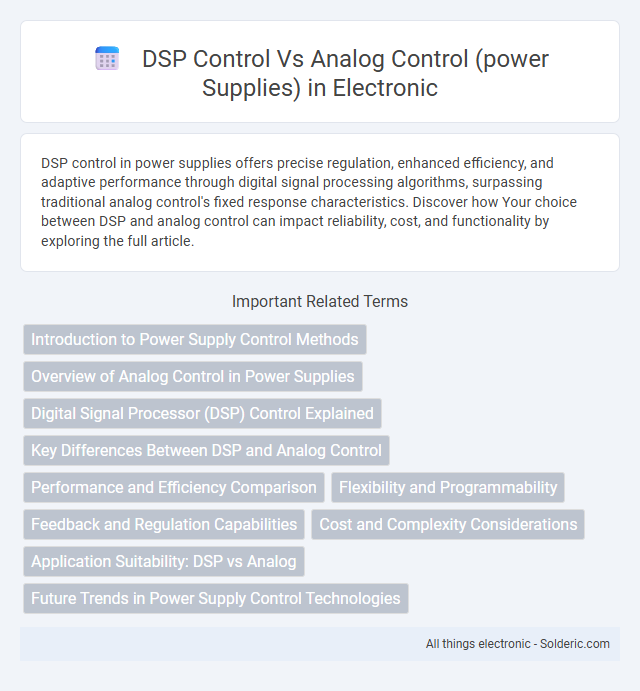DSP control in power supplies offers precise regulation, enhanced efficiency, and adaptive performance through digital signal processing algorithms, surpassing traditional analog control's fixed response characteristics. Discover how Your choice between DSP and analog control can impact reliability, cost, and functionality by exploring the full article.
Comparison Table
| Feature | DSP Control (Power Supplies) | Analog Control (Power Supplies) |
|---|---|---|
| Control Method | Digital Signal Processor-based, programmable | Continuous analog circuitry, fixed control |
| Precision | High accuracy with digital feedback and calibration | Limited by component tolerances and drift |
| Flexibility | Programmable parameters, adaptive control algorithms | Fixed parameters, manual adjustments |
| Response Time | Fast, depends on DSP processing speed | Immediate, continuous analog response |
| Complexity | Higher design and programming complexity | Simpler design, easier to implement |
| Cost | Higher initial cost due to DSP hardware | Lower hardware cost |
| Noise Immunity | Better noise rejection via digital filtering | More susceptible to electrical noise |
| Diagnostics & Monitoring | Advanced diagnostics and real-time monitoring | Limited to basic analog indicators |
| Applications | Complex, adaptive power systems, precision applications | Simple, cost-sensitive, and legacy systems |
Introduction to Power Supply Control Methods
DSP control in power supplies utilizes digital signal processors to precisely regulate voltage and current through programmable algorithms, enabling adaptive response and improved efficiency. Analog control relies on continuous-time components like operational amplifiers and comparators to maintain output stability, offering simplicity and fast transient response but limited flexibility. The choice between DSP and analog control depends on application complexity, with DSP preferred for advanced features such as real-time monitoring, communication, and fault diagnostics.
Overview of Analog Control in Power Supplies
Analog control in power supplies relies on continuous voltage or current signals to regulate output, utilizing components such as operational amplifiers, voltage references, and error amplifiers for precise adjustments. This method offers fast response times and simplicity, making it ideal for applications requiring stable, real-time control without the complexity of digital processing. Despite its advantages, analog control lacks the programmability and adaptive features found in digital systems, limiting flexibility in handling complex power management tasks.
Digital Signal Processor (DSP) Control Explained
Digital Signal Processor (DSP) control in power supplies leverages advanced algorithms to precisely regulate voltage and current, offering superior accuracy and dynamic response compared to traditional analog control. DSPs enable real-time monitoring and adaptive adjustments, reducing noise and improving efficiency through programmable parameters and fault detection mechanisms. This digital approach enhances flexibility, scalability, and integration with communication interfaces, making it ideal for complex and high-performance power management systems.
Key Differences Between DSP and Analog Control
DSP control in power supplies offers digital precision, programmability, and adaptive feedback algorithms, enabling real-time adjustments for enhanced efficiency and stability. Analog control relies on continuous voltage or current signals with fixed components, providing simplicity and low latency but limited flexibility and scalability. The core difference lies in DSP's software-driven adaptability versus analog's hardware-based fixed response, impacting performance, customization, and fault diagnosis capabilities.
Performance and Efficiency Comparison
DSP control in power supplies offers superior performance and efficiency compared to analog control by enabling precise real-time monitoring and adaptive regulation through advanced algorithms. This digital approach reduces power losses, enhances transient response, and supports complex control strategies that optimize energy use under varying load conditions. Your power supply benefits from improved stability and lower heat generation, resulting in longer lifespan and reduced operational costs.
Flexibility and Programmability
DSP control in power supplies offers superior flexibility and programmability compared to analog control, enabling precise real-time adjustments through digital signal processing algorithms. This approach allows you to implement complex control strategies, customize response characteristics, and easily update firmware to adapt to changing application requirements. Analog control circuits, while simpler and faster in response, lack the adaptability and advanced tuning capabilities that DSP-based systems provide for dynamic and optimized power management.
Feedback and Regulation Capabilities
DSP control in power supplies offers superior feedback and regulation capabilities by enabling precise digital monitoring and real-time adjustments, enhancing stability and efficiency. Analog control relies on fixed circuit components, which limits adaptability and may result in slower response times to load or input variations. Your system benefits from DSP control through improved accuracy, reduced noise, and the ability to implement complex algorithms for optimal voltage and current regulation.
Cost and Complexity Considerations
DSP control in power supplies typically incurs higher initial costs and increased design complexity due to advanced digital components and programming requirements, while analog control offers a more cost-effective and simpler solution with easier implementation and faster time-to-market. You may find that DSP control provides superior precision and flexibility in regulation and fault management but demands skilled development resources and more elaborate debugging processes. Analog control remains favored for straightforward applications where minimal cost and simplicity are paramount, especially in low to medium power supplies.
Application Suitability: DSP vs Analog
DSP control in power supplies excels in applications requiring precise regulation, adaptive response to varying loads, and complex control algorithms, making it ideal for renewable energy systems and advanced industrial machinery. Analog control remains suitable for simpler, cost-sensitive applications where fast transient response and minimal latency are critical, such as basic consumer electronics or legacy systems. The choice between DSP and analog control depends on the need for flexibility, programmability, and integration with digital monitoring platforms versus the demand for simplicity and low-noise operation.
Future Trends in Power Supply Control Technologies
Future trends in power supply control technologies emphasize the shift from traditional analog control to digital signal processing (DSP) control due to its enhanced precision, programmability, and efficiency. DSP control enables real-time monitoring, adaptive algorithms, and advanced fault diagnostics, significantly improving power supply performance and reliability. Your power management strategy will benefit from embracing DSP control as it supports integration with IoT devices and smart grid applications, driving the evolution of energy-efficient systems.
DSP control vs analog control (power supplies) Infographic

 solderic.com
solderic.com